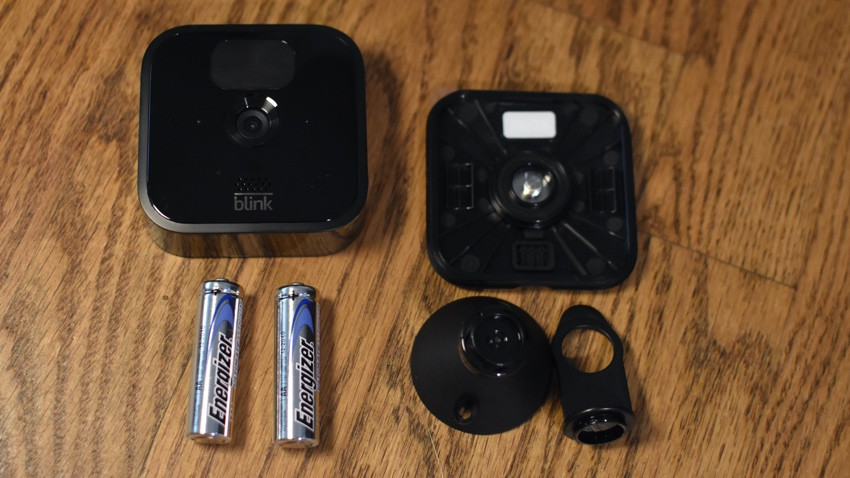Accessories
Does the Mini Blinker have to be plugged in for Power on or does it have a battery?

Modern technology would not be possible without using batteries, and this has been the case for quite some time If you want to keep an eye on your Smart cameras and home security systems.
You’ll need reliable power. With this in mind, you may be wondering whether lithium batteries are required for Blink cameras. The bundled two AA lithium batteries in Blink cameras are not rechargeable and have an estimated two-year lifetime.
While they are widely available, Blink does not recommend using rechargeable or alkaline batteries since they may impair the performance of your camera. This article will provide a deeper dive into the battery use of Blink cameras and provide tips on how to get the most out of your camera’s power supply.

With your Blink Camera, what kind of batteries do you recommend?
Blink cameras need size AA 1.5-volt Lithium non-rechargeable batteries, which are the only kind of battery the cameras will accept.
Batteries: Lithium vs. Alkaline
Alkaline batteries, designed for “low-drain” devices, will have a significantly shortened lifetime if used in security cameras, which are considered “high-drain” equipment.
Batteries for Blink cameras should be recycled at approved recycling centres or via the manufacturer’s recycling program to minimize their influence on the environment when no longer in use.
As was mentioned briefly before, the Blink cameras are powered by four AA lithium-ion batteries (not including the Blink Mini, which has a micro-USB power adapter).

Blink estimates that the batteries will last the average user for two years (with standard usage).
Blink considers 4,000 events of five seconds or less each year, which amounts to around 15 hours of video recording, to be “typical usage” (including Live View).
Yet, several factors might impact how long the batteries in your camera last. If one of your cameras is experiencing “high use,” where its battery dies more quickly than usual, you can rest well knowing that Blink will send you an alert.
Their cameras are more flexible because of an increased focal length and more customization options. Since you now know what kind of batteries Blink cameras need, you may be asking whether regular alkaline batteries would work. As we now have a complete picture of the current battery landscape.
To further understand why Blink suggests lithium batteries, let’s compare them to other common types of batteries like alkaline.
Lithium batteries have a far greater energy density than any other kind of battery, even when comparing cells of the same size. These batteries can hold far more energy than standard alkaline ones and keep working even when the temperature rises over 200 degrees.
These batteries are roughly five times more costly than standard alkaline ones, but they are expected to last around ten times as long. Using alkaline batteries, which are designed for “low-drain” items like alkaline watches, in a security camera would significantly reduce its lifetime since security cameras are considered “high-drain” equipment.
The lithium battery in a digital camera can take around 200 shots (with the flash) before it has to be changed, but the alkaline battery in the same camera can only take about 40 shots. As a result, your Blink camera may not function properly if you put alkaline batteries in it.
Tips and tricks for maximizing the life of the battery in your Blink camera, such as
- Put in the battery size and type suggested by the manufacturer.
- Keep batteries away from heat and moisture.
- Put the camera to sleep while it’s not being used.
- A battery tester or monitor should be used.
- As soon as the batteries are completely charged, remove them from the charger.
Battery terminals should be cleaned regularly, and low-cost or low-quality batteries should be avoided. Keeping the camera out of direct sunlight and away from freezing temperatures.
High-definition (HD) cameras that won’t break the bank
Wasted batteries, particularly single-use alkaline batteries, may harm the environment. Toxic chemicals may leach out of these batteries when they wind up in landfills. Making batteries also require a lot of energy and materials, which results in pollution and global warming.
Recommending rechargeable batteries in Blink cameras might help lessen their environmental effect by lowering the number of disposable batteries that need to be manufactured and disposed of.
https://www.youtube.com/watch?v=AugtfZD1dqI
The correct recycling of batteries is another technique to lessen their negative effects on the environment. Battery recycling programs are offered by several retailers and non-profits.
It would be helpful if you informed your readers about where they might go to recycle their old batteries and if you urged them to do so when the time came.

Battery Choices for Blink Cameras
If you wish to use a different power source with your Blink cameras, you have a few options to choose from. Lower battery life may come from using a gadget in a way that is inconsistent with its intended purpose, therefore users should be aware of this.
Electrical Power Cables and Connectors
Several models of Blink security cameras may be powered by an external source, such as an AC adapter or a USB port.
For instance, the Blink XT and XT2 rely on batteries but can also be charged through a USB connection and converter.
Moreover, all variants may be used indoors or outdoors, giving them a great option for individuals who would rather not use batteries.
Extra-long, weatherproof, and tangle-free cables, such as the kind found on Amazon, are also available for the XT and XT2.
Power cords and adapters: a few things to keep in mind
To ensure your Blink camera is always powered, you need to choose the appropriate wire length. Worse performance and accelerated battery depletion are possible outcomes of using longer connections due to voltage drop or increased resistance.
The cable’s quality is also important since it might affect whether or not the camera receives enough power. High-quality cables developed for use with Blink cameras are suggested.
It’s vital to utilize the manufacturer-recommended adapter for your device. You risk damaging your camera and shortening the life of your batteries if you use an adapter that supplies more voltage or amperage than is suggested.
Blink cameras can be powered by USB cables and adapters, although they may not operate as well as the specified power source. If a USB cable is to be used, one should choose one of sufficient quality to provide the necessary power.
Powering Blink cameras is possible through standard outlets, solar panels, and other green options. This may make battery use less harmful to the environment while also providing a more long-term solution for energy needs.
Make that the camera’s power needs can be met by the solar panel or another renewable energy source.
Battery Packs that can be Charged Again and Over
Although Blink is emphatic in its declaration that “rechargeable Li-Ion, Ni-Cd, and Ni-MH batteries are incompatible,” you may be curious as to the reasoning behind this statement or the many options available to you in terms of rechargeable power.
Using rechargeable batteries with Blink cameras is not dangerous, however, it may boost the camera’s performance.
Without the power efficiency of a lithium battery, your camera may be unable to use features like a live view or recording.
This is because a rechargeable battery cannot provide enough power for your camera. Customers who have tried using rechargeable batteries have reported that the frequent need to recharge them became an inconvenience, especially when the camera was installed in a high-foot-traffic area (as this would rapidly drain the battery).
Arguments for and against utilizing rechargeable batteries
Pros:
- Rechargeable batteries may be more cost-effective than disposable ones since they can be used numerous times before dying.
- Having to regularly buy new batteries and dispose of old ones is something you never have to bother about with rechargeable batteries, which is a huge time saver.
- Rechargeable batteries are better for the environment since they extend the life of existing batteries and cut down on the need for brand-new batteries.

Cons:
- Initial investment Rechargeable batteries and chargers might be more expensive than disposables.
Performance:
Under high-drain or very cold conditions, rechargeable batteries may not function as well as disposable ones.
Regular charging and storing in a cool, dry area are only two examples of the upkeep that rechargeable batteries need.
Overall, utilizing rechargeable batteries to power Blink cameras may be more cost-effective and ecologically friendly, but they may need more initial investment and upkeep. Optimal
performance may be achieved by selecting high-quality rechargeable batteries according to the manufacturer’s charging and storage guidelines.
Reduced downtime is achieved by rapid charging, and the fast rate of discharge provided by lithium is ideal for short-term power surges.
Lithium’s fast rate of discharge is ideal for a short burst of power, and the batteries’ rapid charging time helps keep downtime to a minimum.
Supplemental Battery Pack
But what if you find out that you need to replace your lithium batteries sooner than the two years that the manufacturer claims they would last
Because of the high foot activity in this area, the camera’s motion detection and other power-hungry features may be activated often.
The “Battery Expansion Kit” that Blink offers is meant to provide your batteries an additional 2 years of life.
As soon as you connect this accessory pack to your camera, you may use four AA lithium batteries instead of two, thereby increasing the amount of time your camera can run on a single set of batteries.
Expandable Pack for Blink Camera Batteries:
Pros:
- The Extension Pack helps lengthen the amount of time between battery changes for your Blink cameras.
- The Expansion Pack comes with a charging port that can juice up both batteries at once, making it easy to have your Blink camera ready to go at all times.
- The Extension Pack may save some customers money compared to purchasing extra batteries for their Blink cameras.
Cons:
- Those with many Blink cameras or heavy use may find that the Expansion Pack’s two batteries are insufficient.
- Nevertheless, under the high drain or very cold conditions, the Extension Pack’s batteries may not live up to the standards set by the original Blink camera batteries.
- While the Expansion Pack might save some customers money, it is still an added investment that not everyone can afford.
You should think about the benefits and drawbacks listed above before choosing whether the Extension Pack is right for your Blink camera configuration.
FAQS about Blink Mini
When the Blink Camera’s flash turns blue, what does it mean?
Your camera has malfunctioned if the blue light is blinking or not on at all. If the camera’s blue power light is out, it’s due to not getting any juice.
At What Where Would My Blink Sync Module Be Most Convenient To Me?
We recommend positioning your Sync Module where it will get optimal signals from your Wi-Fi router and cameras. As a result, performance levels will soar. In some situations, you may have to reposition the camera.
Where do withdrawn videos from Blink go?
After being removed from Blink’s servers, erased videos cannot be recovered under any circumstances. If you erase a clip from the Blink app’s cloud storage, it disappears instantly and cannot be recovered.
It is for your protection. Videos and Live Views recorded during a Blink trial or membership period are included.
Conclusion
The bundled two AA lithium batteries in Blink cameras are not rechargeable and have an estimated two-year lifetime. For the sake of your camera’s performance, Blink advises against using either rechargeable or alkaline batteries.
Lithium batteries have an unprecedentedly high energy density compared to any other kind. Lithium batteries can store far more energy than alkaline batteries and can continue to work even when exposed to very high temperatures.
Many models of the Blink family of security cameras may be powered by external sources such as AC adapters or USB cables. Using rechargeable batteries with Blink cameras is not dangerous, but rather a chance to boost your device’s efficiency.
Blink customers may purchase a “Battery Expansion Pack,” which, as the name implies, is meant to increase the battery life of their devices. This battery pack allows you to use four AA lithium batteries with your camera, rather than just two.
-

 Solutions2 years ago
Solutions2 years agoHow to Connect Your Vizio TV to WiFi Easily Without a Remote?
-

 Solutions2 years ago
Solutions2 years agoWhy is My Samsung TV Picture So Dark? Exploring the Possible Causes
-

 Accessories2 years ago
Accessories2 years agoCan A Hdmi Splitter Extend The Display To 2 Monitors?
-

 Gadgets2 years ago
Gadgets2 years agoFitbit Symbols Meaning: What Do The Fitbit Icons Mean?
-

 Accessories2 years ago
Accessories2 years agoDo Smart Thermostats Run On Batteries? Let’s Find Out
-

 Solutions2 years ago
Solutions2 years agoWhy Can’t I Stream Netflix From My Phone? | Solution
-

 Solutions2 years ago
Solutions2 years ago8 Ways How To Stop Google Home Nest From Crackling
-

 Solutions2 years ago
Solutions2 years agoHow To Fix Charging Not Available? Iphone Liquid Detected




